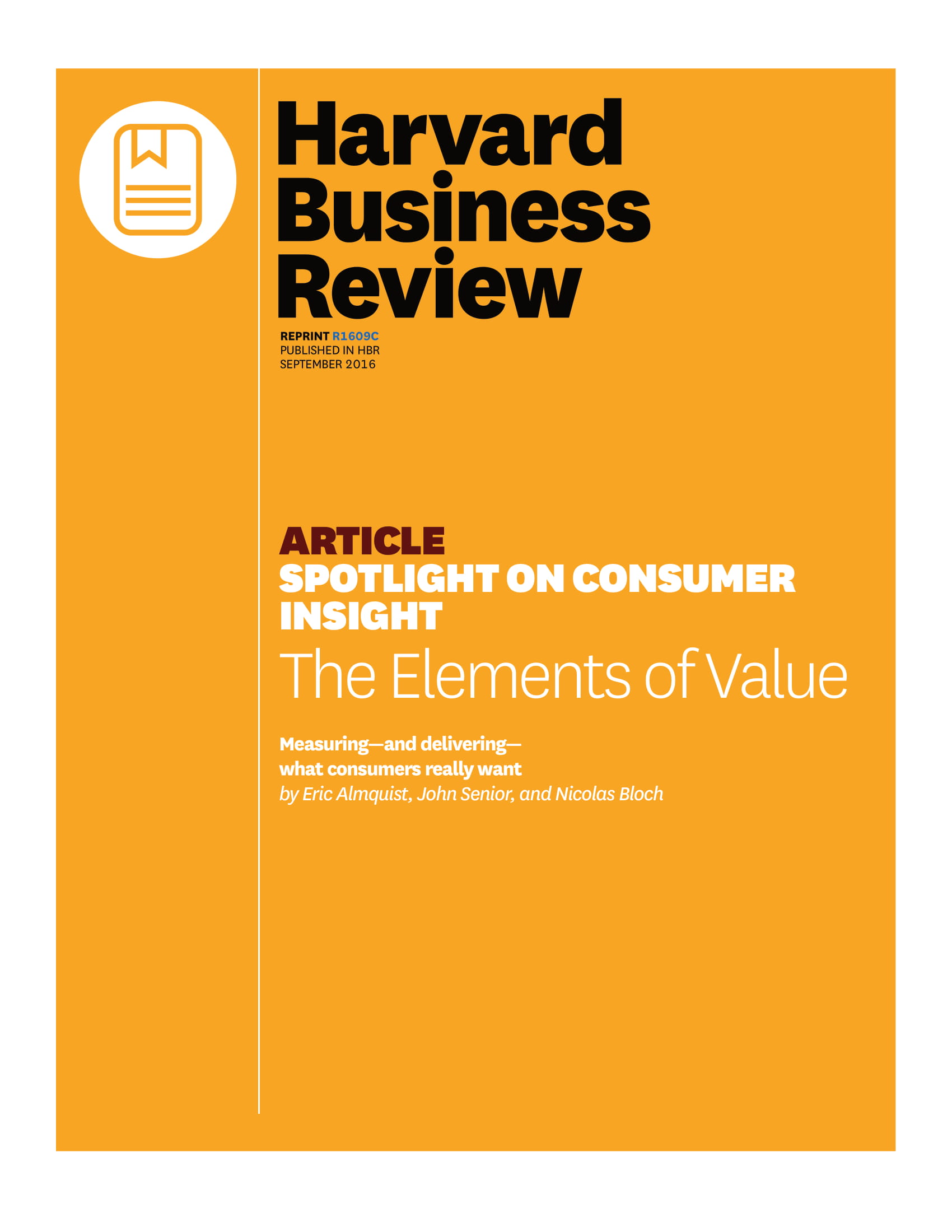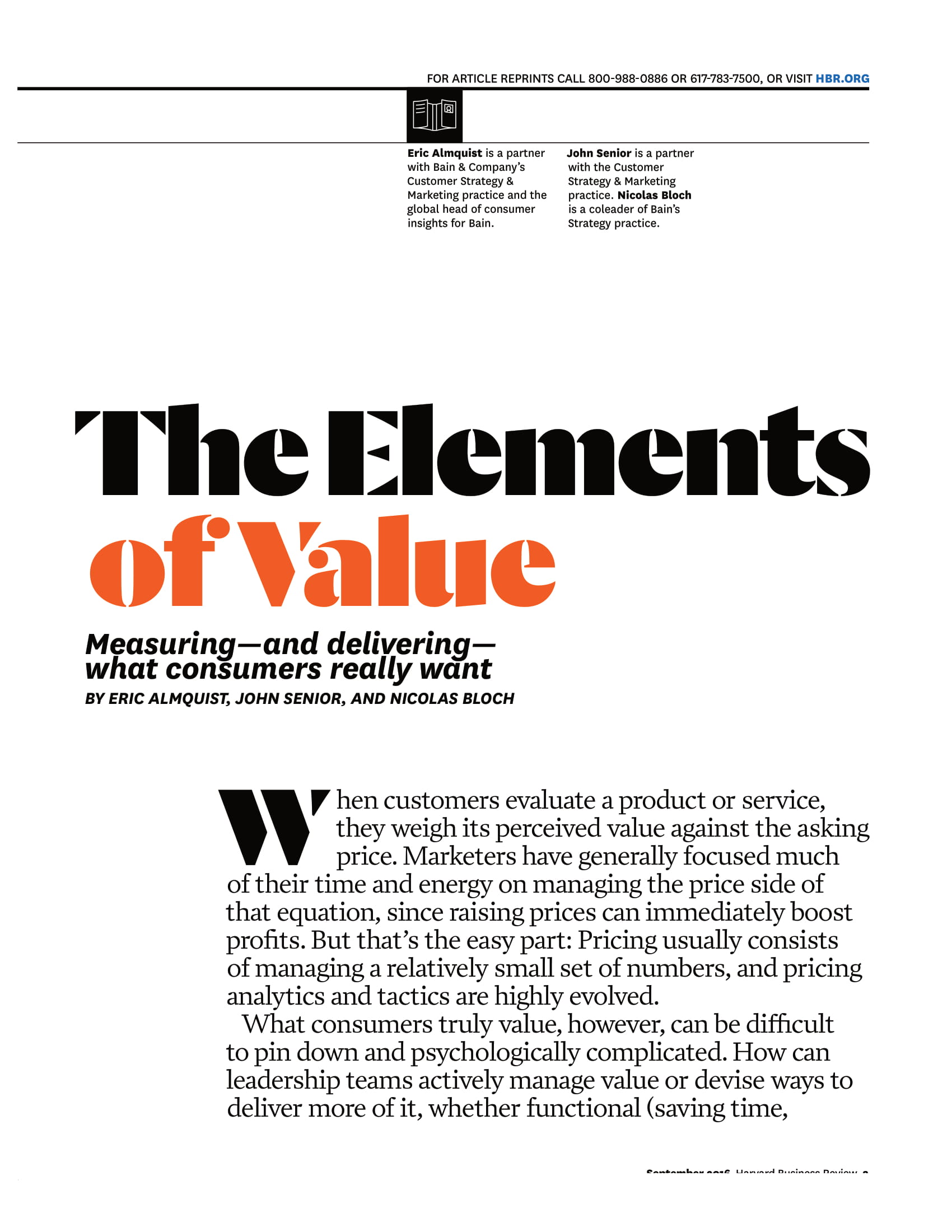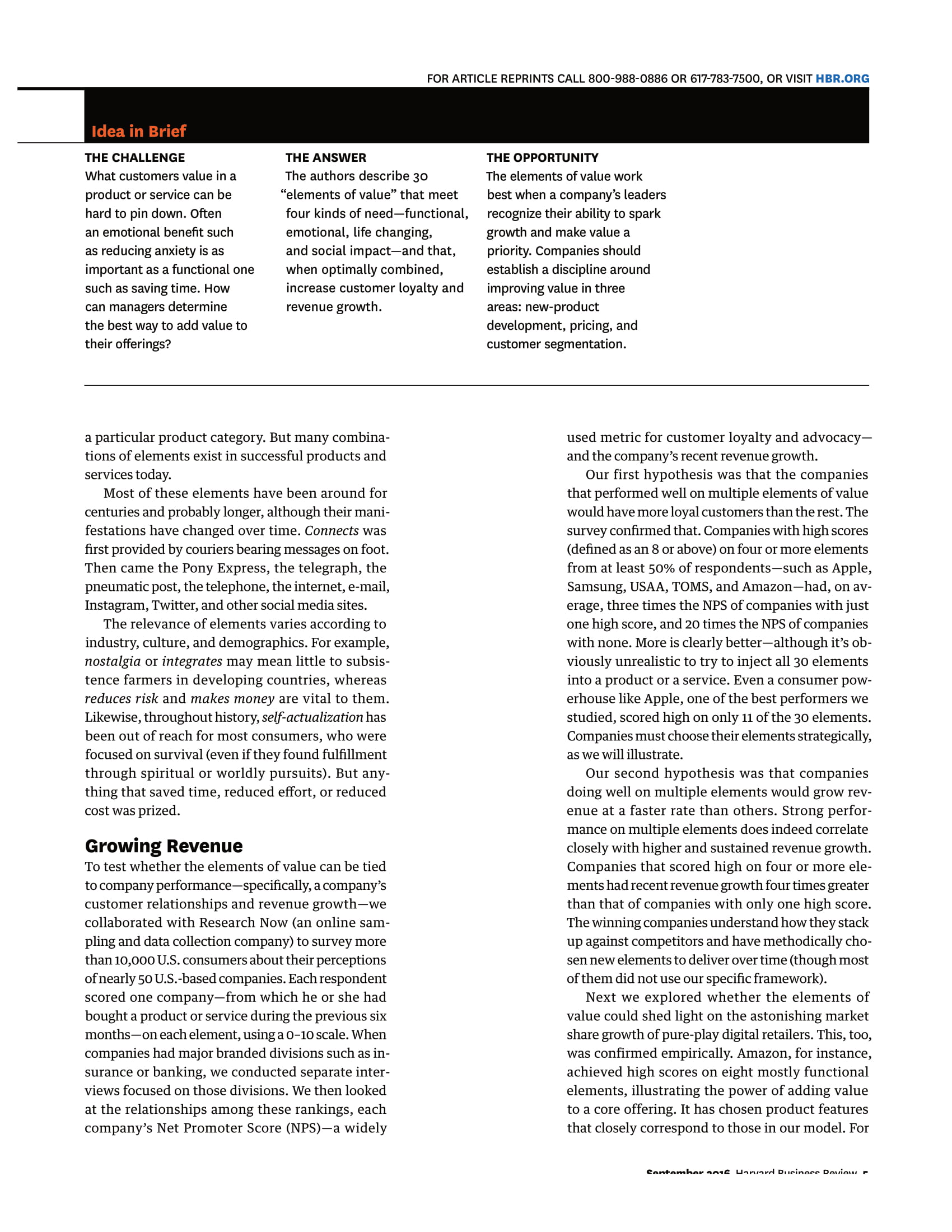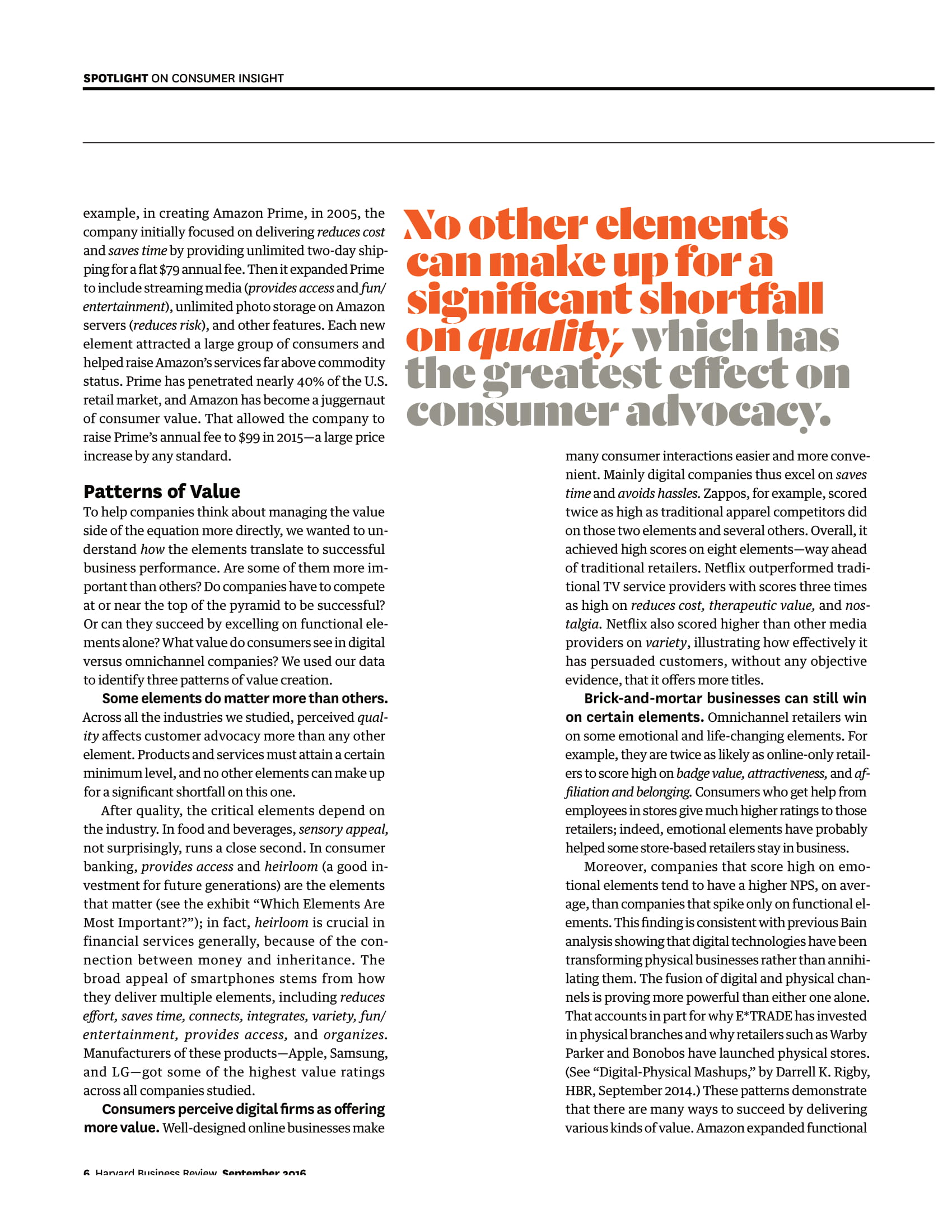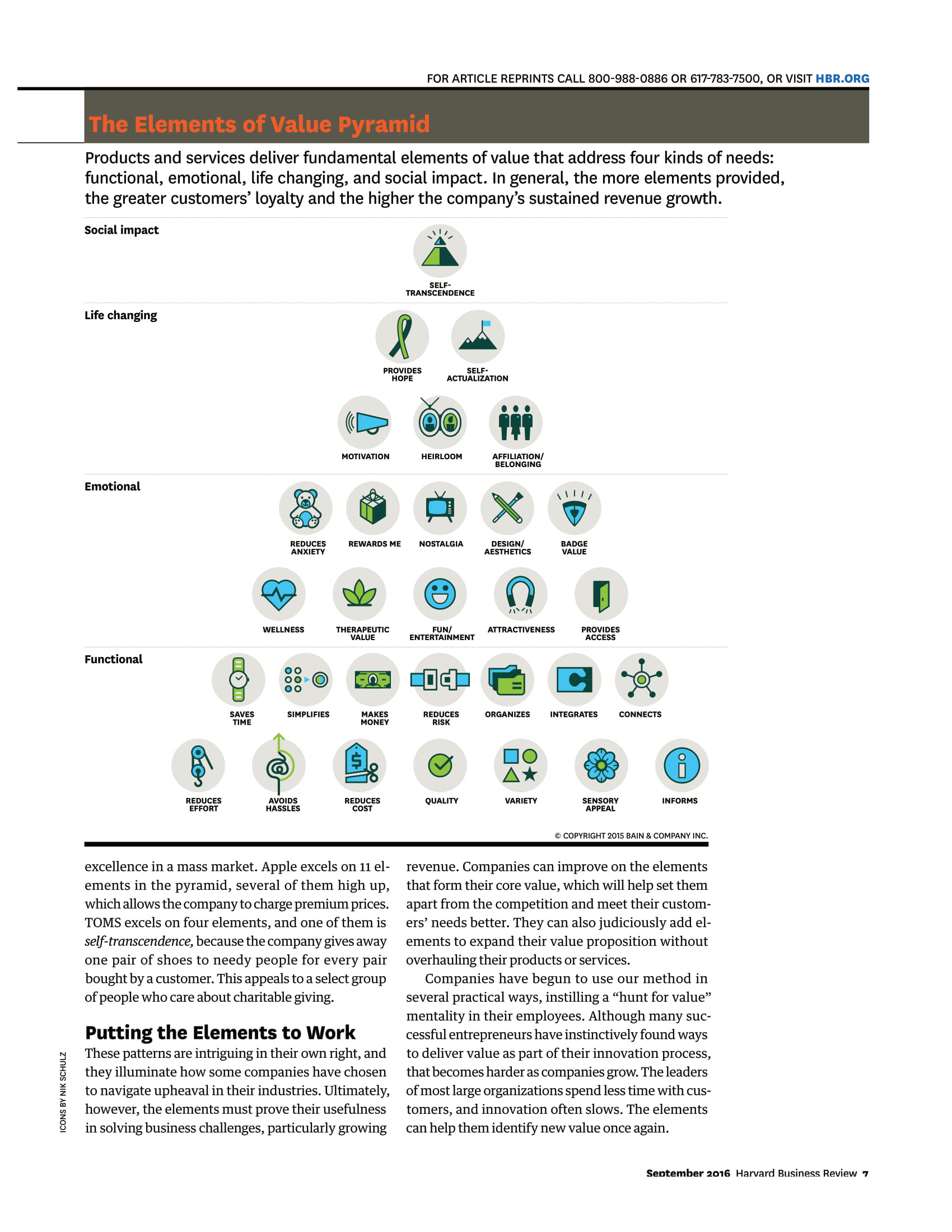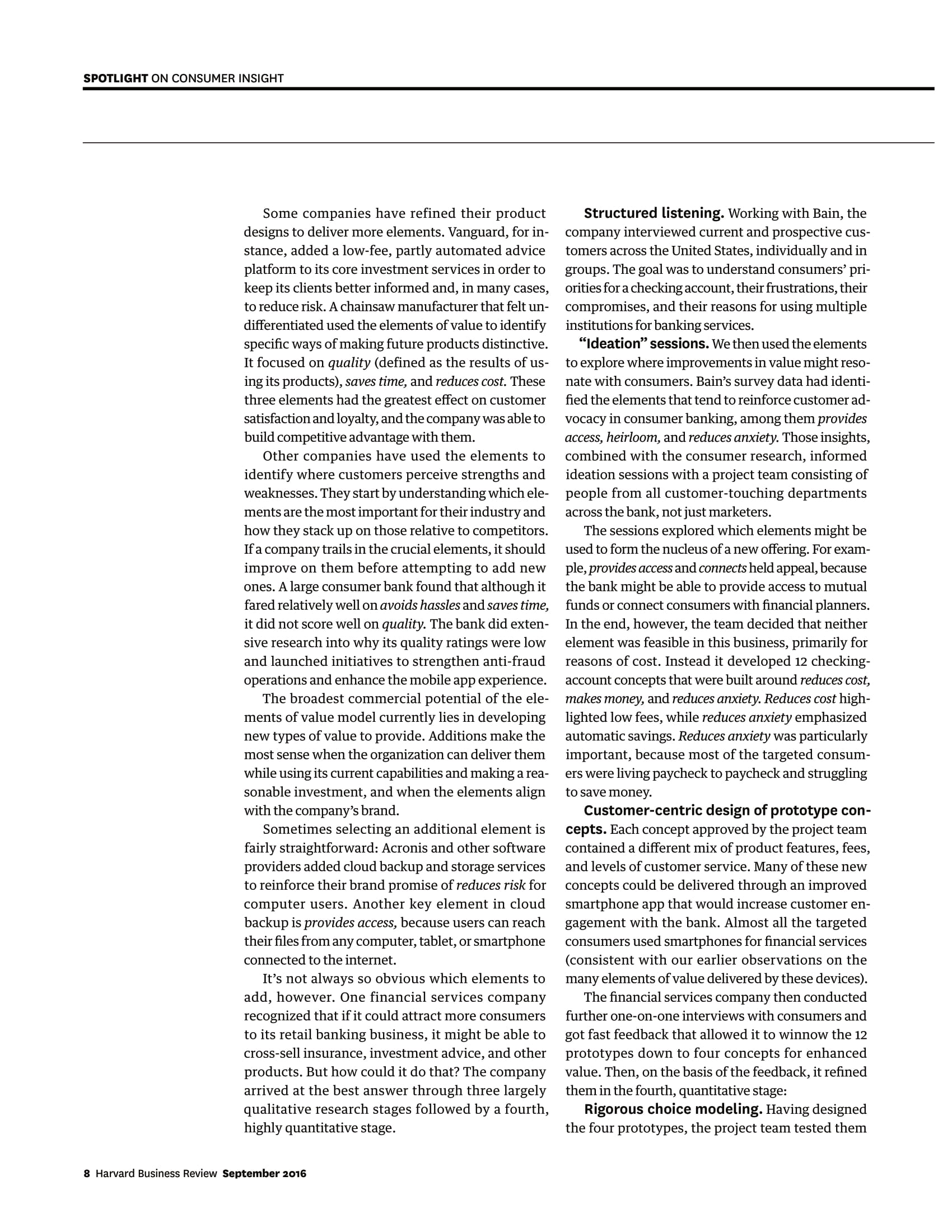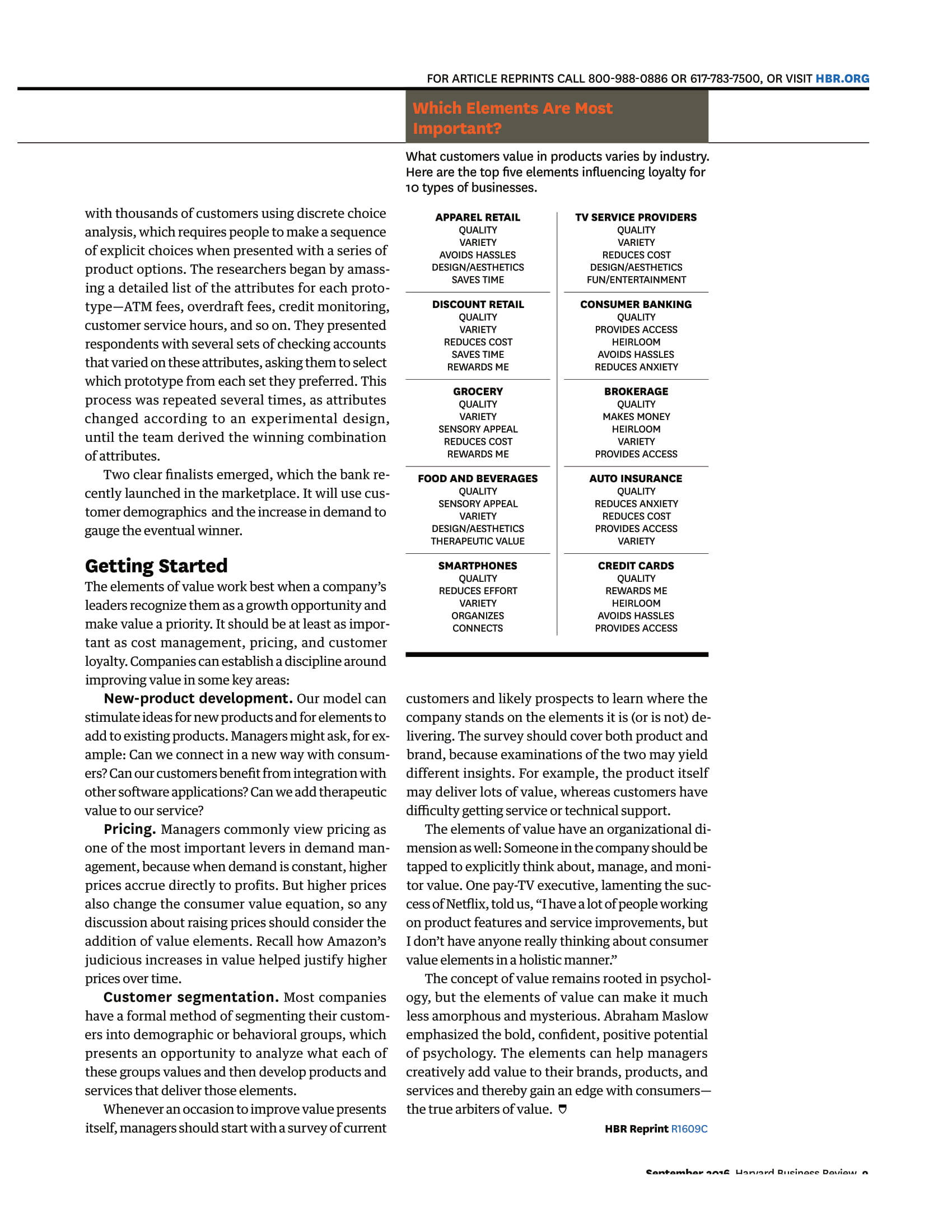summary for this article : key theme, major findings, and key implications
Harvard Business Review REPRINT R1609C PUBLISHED IN HBR SEPTEMBER 2016 ARTICLE SPOTLIGHT ON CONSUMER INSIGHT The Elements of Value Measuring-and delivering- what consumers really want by Eric Almquist, John Senior, and Nicolas BlochSPOTLIGHT ON CONSUMER INSIGHT SPOTLIGHT ARTWORK Marijah Bac Cam, InkPulse For Winter -Ill- Ink, acrylic, spray paint, and pastel on paperFOR ARTICLE REPRINTS CALL 800-988-0886 OR 617-783-7500, OR VISIT HBR.ORG W Eric Almquist is a partner John Senior is a partner with Rain 8. Company's with the Customer Customer Strategy 8. Strategy 8. Marketing Marketing practice and the practice. Nicolas Bloch global head of consumer is a coleader of Bain's insights for Bain. Strategy practice. The Elements of Value Measuringand delivering what consumers really want BY ERIC ALMQUIST; JOHN SENIOR, AND NICOLAS BLOCH 7 hen customers evaluate a product or service, \" they weigh its perceived value against the asking price. Marketers have generally focused much of their time and energy on managing the price side of that equation, since raising prices can immediately boost prots. But that's the easy part: Pricing usually consists of managing a relatively small set of numbers, and pricing analytics and tactics are highly evolved. What consumers truly value, however, can be difficult to pin down and psychologically complicated. How can leadership teams actively manage value or devise ways to deliver more of it, whether functional (saving time, e_._a..._l.-_ _..-a u-.......J non-:ulA-n n...:-... .- SPOTLIGHT ON CONSUMER INSIGHT reducing cost) or emotional (reducing anxiety, pro viding entertainment)? Discrete choice analysis which simulates demand for different combinations of product features, pricing, and other components and similar research techniques are powerful and useil tools, but they are designed to test consumer reactions to preconceived concepts of valuethe concepts that managers are accustomed to judging. Coming up with new concepts requires anticipating what else people might consider valuable. The amount and nature of value in a particular product or service always lie in the eye of the be- holder, of course. Yet universal building blocks of value do exist, creating opportunities for companies to improve their performance in current markets or break into new ones. A rigorous model of consumer value allows a company to come up with new com- binations of value that its products and services could deliver. The right combinations, our analysis shows, pay off in stronger customer loyalty, greater consumer willingness to try a particular brand, and sustained revenue growth. We have identied 30 \"elements of value\"fun- damental attributes in their most essential and dis- crete forms (see the exhibit \"The Elements of Value Pyramid\"). These elements fall into four categories: functional, emotional, life changing, and social im- pact. Some elements are more inwardly focused, pri malily addressing consumers' personal needs. For example, the life-changing element motivation is at the core of Fitbit's exercise-tracking products. Others are outwardly focused, helping customers interact in or navigate the external world. The functional ele- ment organizes is central to The Container Store and Intuit's TurboTax, because both help consumers deal with complexities in their world. In our research we don't accept on its face a con sumer's statement that a certain product attribute is The elements of 'alue extend )Iaslow's \"hierarchy ofneetls\" by focusing on people as consumers. 4 Harvard Business Review September 2018 important; instead we explore what underlies that statement. For example, when someone says her bank is \"convenien ,\" its value derives from some combination of the functional elements saves time, avoids hassle, simplies, and reduces e'ort. And when the owner of a $10,000 Leica talks about the quality of the product and the pictures it takes, an underly- ing life-changing element is selfactuaiizaiion, aris- ing from the pride of owning a camera that famous photographers have used for a century. Three decades of experience doing consumer re- search and observation for corporate clients led us to idenfy these 30 fundamental attributes, which we derived from scores of quantitative and qualita- tive customer studies. Many of the studies involved the well-known interviewing technique \"laddering,\" which probes consumers' initial stated preferences to identify what's driving them. Our model traces its conceptual roots to the psy- chologist Abraham Maslow's \"hierarchy of needs,\" which was first published in 1943. Then a faculty member at Brooklyn College, Maslow argued that human actions arise from an innate desire to ful- fill needs ranging from the very basic (security, warmth, food, rest) to the complex (self-esteem, altruism). Almost all marketers today are familiar with Maslow's hierarchy. The elements of value ap- proach extends his insights by focusing on people as consumersdescribing their behavior as it relates to products and services. It may be useful to briey compare Maslow's thinking with our model. Marketers have seen his hi- erarchy organized in a pyramid (although it was later interpreters, not Maslow himself, who expressed his theory that way). At the bottom of the pyramid are physiological and safety needs, and at the top are self-actualization and self-transcendence. The popular assumption has been that people cannot attain the needs at the top until they have met the ones below. Maslow himself took a more nuanced View, realizing that numerous patterns of fulfillment can exist. For example, rock climbers achieve self- actualization in unroped ascents of thousands of feet, ignoring basic safety considerations. Similarly, the elements of value pyramid is a heuristic modelpractical rather than theoreti- cally perfectin which the most powerful forms of value live at the top. To be able to deliver on those higher-order elements, a company must provide at least some of the functional elements required by FOR ARTICLE REPRINTS CALL 800-988-0886 OR 617-783-7500, OR VISIT HBRDRG THE CHALLENGE what customers value in a product or service can be hard to pin down. Often an emotional benet such as reducing anxiety is as important as a functional one such as saving time. How can managers determine THE ANSWER The authors describe 30 \"elements of value\" that meet four kinds of needfunctional, emotional, life changing, and social impactand that, when optimally combined, increase customer loyalty and revenue growth. the best way to add value to their offerings? a particular product category. But many combina tions of elements exist in successful products and services today. Most of these elements have been around for centuries and probably longer, although their mani- festations have changed over time. Connects was rst provided by couriers bearing messages on foot. Then came the Pony Express, the telegraph, the pneumatic post, the telephone, the intemet, e-mail, Instagram, Twitter, and other social media sites. The relevance of elements varies according to industry, culture, and demographics. For example, nostalgia or integrates may mean little to subsis tence farmers in developing countries, whereas reduces risk and makes money are vital to them. Likewise, throughout history, selactualization has been out of reach for most consumers, who were focused on survival (even if they found fulfillment through spiritual or worldly pursuits). But any thing that saved time, reduced effort, or reduced cost was prized. Growing Revenue To test whether the elements of value can be tied to company performancespecically, a company's customer relationships and revenue growthwe collaborated with Research Now (an online sam- pling and data collection company) to survey more than 10,000 US. consumers about their perceptions of nearly 50 U.S.-based companies. Each respondent scored one companyfrom which he or she had bought a product or service during the previous six monthson each element, using a 0-10 scale. When companies had major branded divisions such as in surance or banking, we conducted separate inter- views focused on those divisions. We then looked at the relationships among these rankings, each company's Net Promoter Score (NPS)a widely THE OPPORTUNITY The elements of value work best when a company's leaders recognize their ability to spark growth and make value a priority. Companies should establish a discipline around improving value in three areas: new-product development, pricing, and customer segmentation. used metric for customer loyalty and advocacy and the company's recent revenue growth. Our first hypothesis was that the companies that performed well on multiple elements of value would have more loyal customers than the rest. The survey conrmed that. Companies with high scores (dened as an 8 or above) on four or more elements from at least 50% of respondentssuch as Apple, Samsung, USAA, TOMS, and Amazonhhad, on av- erage, three times the NPS of companies with just one high score, and 20 times the NPS of companies with none. More is clearly betterwalthough it's ob- viously unrealistic to try to inject all 30 elements into a product or a service. Even a consumer pow- erhouse like Apple, one of the best performers we studied, scored high on only 11 of the 30 elements. Companies must choose their elements strategically, as we will illustrate. Our second hypothesis was that companies doing well on multiple elements would grow rev- enue at a faster rate than others. Strong perfor- mance on multiple elements does indeed correlate closely with higher and sustained revenue growth. Companies that scored high on four 01' more ele- ments had recent revenue growth four times greater than that of companies with only one high score. The winning companies understand how they stack up against competitors and have methodically cho- sen new elements to deliver over time (though most of them did not use our specic framework). Next we explored whether the elements of value could shed light on the astonishing market share growth of pure-play digital retailers. This, too, was conrmed empirically. Amazon, for instance, achieved high scores on eight mostly functional elements, illustrating the power of adding value to a core offering. It has chosen product features that closely correspond to those in our model. For e-_A-I.-_ nan- uqnmwl mud-\"gm- Dan-inn: - SPOTLIGHT ON CONSUMER INSIGHT example, in creating Amazon Prime, in 2005, the company initially focused on delivering reduces cost and saves time by providing unlimited two-day ship- ping for a at $79 annual fee. Then it expanded Prime to include streaming media (provides access and fun/ entertainment), unlimited photo storage on Amazon servers (reduces risk), and other features. Each new element attracted a large group of consumers and helped raise Amazon's services far above commodity status. Prime has penetrated nearly 40% of the U.S. retail market, and Amazon has become a juggernaut of consumer value. That allowed the company to raise Prime's annual fee to $99 in 2015a large price increase by any standard. Patterns of Value To help companies think about managing the value side of the equation more directly, we wanted to un- derstand how the elements translate to successful business performance. Are some of them more im- portant than others? Do companies have to compete at or near the top of the pyramid to be successful? Or can they succeed by excelling on functional ele- ments alone? What value do consumers see in digital versus omnichannel companies? We used our data to identify three patterns of value creation. Some elements do matter more than others. Across all the industries we studied, perceived qual ity affects customer advocacy more than any other element. Products and services must attain a certain minimum level, and no other elements can make up for a signicant shortfall on this one. After quality, the critical elements depend on the industry. In food and beverages, sensory appeal, not surprisingly, runs a close second. In consumer banking, provides access and heirloom (a good in- vestment for future generations) are the elements that matter (see the exhibit \"Which Elements Are Most Important?\"); in fact, heirloom is crucial in financial services generally, because of the con nection between money and inheritance. The broad appeal of smartphones stems from how they deliver multiple elements, including reduces effort, saves time, connects, integrates, variety, fun/ entertainment, provides access, and organizes. Manufacturers of these productsApple, Samsung, and LGgot some of the highest value ratings across all companies studied. Consumers perceive digital rms as offering more value. Well-designed online businesses make R Harvard Elleinaee Dmnw Cant-Inks! am: No other elements can make up for a significant shortfall on quality; which has the greatest effect on consumer advocacy. many consumer interactions easier and more conve- nient. Mainly digital companies thus excel on saves time and avoids hassles. Zappos, for example, scored twice as high as traditional apparel competitors did on those two elements and several others. Overall, it achieved high scores on eight elementsway ahead of traditional retailers. Netix outperformed tradi- tional TV service providers with scores three times as high on reduces cost, therapeutic value, and nos- talgia. Netix also scored higher than other media providers on variety, illustrating how effectively it has persuaded customers, without any objective evidence, that it offers more titles. Brick-and-mortar businesses can still win on certain elements. Omnichannel retailers win on some emotional and life-changing elements. For example, they are twice as likely as online-only retail- ers to score high on badge value, attractiveness, and af- liation and belonging. Consumers who get help from employees in stores give much higher ratings to those retailers; indeed, emotional elements have probably helped some store-based retailers stay in business. Moreover, companies that score high on emo- tional elements tend to have a higher NPS, on aver- age, than companies that spike only on mctional el- ements. This finding is consistent with previous Bain analysis showing that digital technologies have been transforming physical businesses rather than annihi- lating them. The fusion of digital and physical chan- nels is proving more powerful than either one alone. That accounts in part for why E\" TRADE has invested in physical branches and why retailers such as Warby Parker and Bonobos have launched physical stores. (See "Digital-Physical Mashups,\" by Darrell K. Rigby, HBR, September 2014.) These patterns demonstrate that there are many ways to succeed by delivering various ldnds of value. Amazon expanded functional FOR ARTICLE REPRINTS CALL 800-988-0886 OR 617-783-7500, OR VISIT HBR.ORG The Elements of Value Pyramid Products and services deliver fundamental elements of value that address four kinds of needs: functional, emotional, life changing, and social impact. In general, the more elements provided, the greater customers' loyalty and the higher the company's sustained revenue growth. Social impact SELF- TRANSCENDENCE Life changing ROVIDES ACTUALIZATION MOTIVATION HEIRLOOM AFFILIATION BELONGING Emotional REDUCES ANXIETY REWARDS ME NOSTALGIA DESIGN/ AESTHETICS BADGE VALUE WELLNESS HERAPEUTIC VALUE FUN/ ENTERTAINMENT ATTRACTIVENESS ACCESS Functional ooo O SAVES TIME MPLIFIES MAKES 1ONE REDUCES RISK ORGANIZ INTEGRATES CONNECTS REDUCES EFFORT AVOIDS HASSLES EDUCE COST QUALITY VARIETY SENSORY APPEAL INFORM COPYRIGHT 2015 BAIN & COMPANY INC. excellence in a mass market. Apple excels on 11 el- revenue. Companies can improve on the elements ements in the pyramid, several of them high up, that form their core value, which will help set them which allows the company to charge premium prices. apart from the competition and meet their custom- TOMS excels on four elements, and one of them is ers' needs better. They can also judiciously add el self-transcendence, because the company gives away ements to expand their value proposition without one pair of shoes to needy people for every pair overhauling their products or services. bought by a customer. This appeals to a select group Companies have begun to use our method in of people who care about charitable giving several practical ways, instilling a "hunt for value' Putting the Elements to Work mentality in their employees. Although many suc- cessful entrepreneurs have instinctively found ways ICONS BY NIK SCHULZ These patterns are intriguing in their own right, and to deliver value as part of their innovation process, they illuminate how some companies have chosen that becomes harder as companies grow. The leaders to navigate upheaval in their industries. Ultimately, of most large organizations spend less time with cus- however, the elements must prove their usefulness tomers, and innovation often slows. The elements in solving business challenges, particularly growing can help them identify new value once again. September 2016 Harvard Business Review 7SPOTLIGHT ON CONSUMER INSIGHT Some companies have refined their product designs to deliver more elements. Vanguard, for in- stance, added a low-fee, partly automated advice platform to its core investment services in order to keep its clients better informed and, in many cases, to reduce risk. A chainsaw manufacturer that felt un- differentiated used the elements of value to identify specic ways of making future products distinctive. It focused on quality (defined as the results of us- ing its products}, saves time, and reduces cost. These three elements had the greatest effect on customer satisfaction and loyalty, and the company was able to build competitive advantage with them. Other companies have used the elements to identify where customers perceive strengths and weaknesses. They start by understanding which ele- ments are the most important for their industry and how they stack up on those relative to competitors. Ifa company trails in the crucial elements, it should improve on them before attempting to add new ones. A large consumer bank found that although it fared relatively well on avoids hassles and saves time, it did not score well on quality. The bank did exten- sive research into why its quality ratings were low and launched initiatives to strengthen antifraud operations and enhance the mobile app experience. The broadest commercial potential of the ele- ments of value model currently lies in developing new types of value to provide. Additions make the most sense when the organization can deliver them while using its current capabilities and making a rea sonable investment, and when the elements align with the company's brand. Sometimes selecting an additional element is fairly straightforward: Acronis and other software providers added cloud backup and storage services to reinforce their brand promise of reduces risk for computer users. Another key element in cloud backup is provides access, because users can reach their files from any computer, tablet, or smartphone connected to the intemet. It's not always so obvious which elements to add, however. One financial services company recognized that if it could attract more consumers to its retail banking business, it might be able to cross-sell insurance, investment advice, and other products. But how could it do that? The company arrived at the best answer through three largely qualitative research stages followed by a fourth, highly quantitative stage. 8 Harvard Business Review September 1016 Structured listening. Working with Bain, the company interviewed current and prospective cus- tomers across the United States, individually and in groups. The goal was to understand consumers' pri- orities for a checking account, their frustrations, their compromises, and their reasons for using multiple institutions for banking services. \"ldeation\" sessions. We then used the elements to explore where improvements in value might reso- nate with consumers. Bain's survey data had identi- ed the elements that tend to reinforce customer ad- vocacy in consumer banking, among them provides access, heirloom, and reduces anxiety. Those insights, combined with the consumer research, informed ideation sessions with a project team consisting of people from all customer-touching departments across the bank, not just marketers. The sessions explored which elements might be used to form the nucleus of a new offering. For exam- ple, provides access and connects held appeal, because the bank might be able to provide access to mutual funds or connect consumers with nancial planners. In the end, however, the team decided that neither element was feasible in this business, primarily for reasons of cost. Instead it developed 12 checking- account concepts that were built around reduces cost, makes money, and reduces anxiety. Reduces cost high- lighted low fees, while reduces anxiety emphasized automatic savings. Reduces anxiety was particularly important, because most of the targeted consum- ers were living paycheck to paycheck and struggling to save money. Customer-centric design of prototype con- cepts. Each concept approved by the project team contained a different mix of product features, fees, and levels of customer service. Many of these new concepts could be delivered through an improved smartphone app that would increase customer en- gagement with the bank. Almost all the targeted consumers used smartphones for nancial services (consistent with our earlier observations on the many elements of value delivered by these devices). The nancial services company then conducted further one-on-one interviews with consumers and got fast feedback that allowed it to winnow the 12 prototypes down to four concepts for enhanced value. Then, on the basis of the feedback, it rened them in the fourth, quantitative stage: Rigorous choice modeling. Having designed the four prototypes, the project team tested them FOR ARTICLE REPRINTS CALL 800-988-0886 OR 617-783-7500, OR VISIT HBR.ORG Which Elements Are Most Important? What customers value in products varies by industry. Here are the top five elements influencing loyalty for 10 types of businesses. with thousands of customers using discrete choice APPAREL RETAIL QUALITY TV SERVICE PROVIDERS analysis, which requires people to make a sequence QUALIT of explicit choices when presented with a series of VARIET VARIETY AVOIDS HASSLES REDUCES COST product options. The researchers began by amass- DESIGN/AESTHETICS DESIGN/AESTHETICS ing a detailed list of the attributes for each proto- SAVES TIME FUN/ENTERTAINMENT type-ATM fees, overdraft fees, credit monitoring, DISCOUNT RETAIL CONSUMER BANKING customer service hours, and so on. They presented QUALITY QUALITY VARIETY PROVIDES ACCESS respondents with several sets of checking accounts REDUCES COST HEIRLOOM that varied on these attributes, asking them to select SAVES TIME REWARDS M AVOIDS HASSLE REDUCES ANXIETY which prototype from each set they preferred. This process was repeated several times, as attributes GROCERY QUALITY BROKERAGE QUALITY changed according to an experimental design, VARIETY MAKES MONEY until the team derived the winning combination SENSORY APPEAL HEIRLOOM REDUCES COST VARIETY of attributes. REWARDS ME PROVIDES ACCESS Two clear finalists emerged, which the bank re- FOOD AND BEVERAGES AUTO INSURANCE cently launched in the marketplace. It will use cus- QUALITY QUALITY tomer demographics and the increase in demand to SENSORY APPEAL VARIETY REDUCES ANXIETY REDUCES COST gauge the eventual winner. DESIGN/AESTHETICS THERAPEUTIC VALUE PROVIDES ACCESS VARIETY Getting Started SMARTPHONES CREDIT CARDS The elements of value work best when a company's QUALITY REDUCES EFFORT QUALITY REWARDS M leaders recognize them as a growth opportunity and VARIETY HEIRLOOM make value a priority. It should be at least as impor- ORGANIZES AVOIDS HASSLES CONNECTS PROVIDES ACCESS tant as cost management, pricing, and customer loyalty. Companies can establish a discipline around improving value in some key areas: New-product development. Our model can customers and likely prospects to learn where the stimulate ideas for new products and for elements to company stands on the elements it is (or is not) de- add to existing products. Managers might ask, for ex- livering. The survey should cover both product and ample: Can we connect in a new way with consum- brand, because examinations of the two may yield ers? Can our customers benefit from integration with different insights. For example, the product itself other software applications? Can we add therapeutic may deliver lots of value, whereas customers have value to our service? difficulty getting service or technical support. Pricing. Managers commonly view pricing as The elements of value have an organizational di- one of the most important levers in demand man- mension as well: Someone in the company should be agement, because when demand is constant, higher tapped to explicitly think about, manage, and moni- prices accrue directly to profits. But higher prices tor value. One pay-TV executive, lamenting the suc- also change the consumer value equation, so any cess of Netflix, told us, "I have a lot of people working discussion about raising prices should consider the on product features and service improvements, but addition of value elements. Recall how Amazon's I don't have anyone really thinking about consumer judicious increases in value helped justify higher value elements in a holistic manner." prices over time. The concept of value remains rooted in psychol- Customer segmentation. Most companies ogy, but the elements of value can make it much have a formal method of segmenting their custom- less amorphous and mysterious. Abraham Maslow ers into demographic or behavioral groups, which emphasized the bold, confident, positive potential presents an opportunity to analyze what each of of psychology. The elements can help managers these groups values and then develop products and creatively add value to their brands, products, and services that deliver those elements. services and thereby gain an edge with consumers- Whenever an occasion to improve value presents the true arbiters of value. itself, managers should start with a survey of current HBR Reprint R1609C Cantamher 2016 Wancard Dulcinace Devious a
